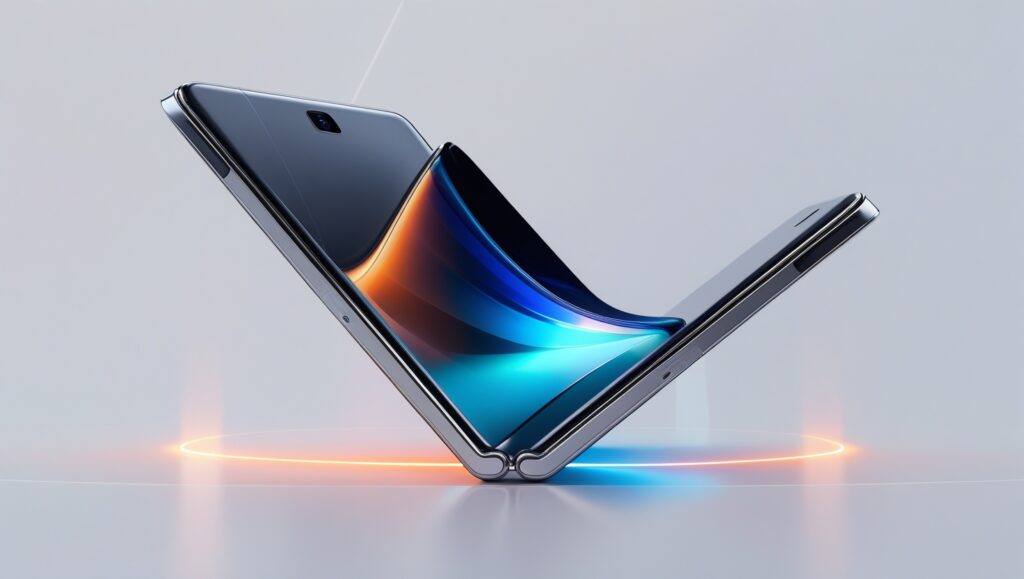Introduction and the Rise of Foldable Smartphones
Introduction: A New Era of Mobile Technology
The smartphone industry has always been a hotbed of innovation, transforming the way we communicate, work, entertain ourselves, and manage everyday tasks. From the bulky mobile phones of the 1990s to today’s sleek, powerful touchscreen devices, the evolution has been rapid and relentless.
But now, the mobile industry is on the cusp of another revolutionary shift: smartphones that break the traditional design mold. The future belongs to foldables, rollables, stretchables, and other flexible form factors that promise to redefine how we interact with mobile technology.
The aim? To deliver larger screens without compromising portability, boost productivity through multitasking capabilities, and offer more immersive entertainment—all while fitting comfortably in your pocket.
What Exactly Are Foldable Smartphones?
Foldable smartphones are devices that use flexible display technology—primarily OLED (Organic Light Emitting Diode)—combined with innovative hinge mechanisms, allowing the phone to fold and unfold. Unlike traditional smartphones with a single rigid screen, foldables can switch between compact and expanded modes.
Typically, foldables fall into two categories:
- Inward folding: Like the Samsung Galaxy Z Fold, where the screen folds inside the device, protecting it when closed.
- Outward folding: Like the Huawei Mate X, where the screen folds outward, creating a larger display surface on the outside.
Historical Milestones in Foldable Technology
The journey to foldables has been long, with many technological breakthroughs paving the way:
- Flexible OLED Development: Early 2000s saw the emergence of OLED technology, which is naturally flexible compared to LCDs.
- First Commercial Foldables: 2018-2019 marked the launch of first-gen foldable phones like Royole FlexPai, Samsung Galaxy Fold, and Huawei Mate X.
- Refinements and Improvements: Each new iteration brought better durability, slimmer hinges, improved displays, and more optimized software.
Advantages of Foldable Smartphones
- Screen Real Estate Without Bulk: Foldables provide large displays comparable to tablets, ideal for media, gaming, and multitasking.
- Portability: Folding design makes large screens pocket-friendly.
- Multitasking: Multiple apps can run side by side, improving productivity.
- Versatile User Experience: Devices can shift form factors based on needs, from compact phone mode to expansive tablet mode.
- Innovation Driver: Foldables push manufacturers to innovate in materials, software, and user experience.
Real-World Examples and Market Adoption
- Samsung Galaxy Z Fold Series: Samsung pioneered the mainstream foldable market, releasing the Galaxy Z Fold and Galaxy Z Flip lines, focusing on durability and user experience.
- Huawei Mate X Series: Huawei’s approach focused on outward folding for a seamless larger screen.
- Motorola Razr: A nostalgic foldable flip phone design with a modern flexible display.
These devices are becoming more affordable and mainstream, with sales increasing steadily each year.
Technical Innovations Behind Foldables
- Flexible OLED Displays: Manufactured with ultra-thin plastic substrates instead of glass, enabling bending without breaking.
- Hinge Mechanisms: Precision engineering allows smooth folding, supporting tens of thousands of folds.
- Software Adaptation: Android and app developers have built support for dynamic screen resizing, split-screen multitasking, and folding-specific UI features.
Challenges Facing Foldables
Despite the promise, foldables still face hurdles:
- Durability: Flexible screens are more fragile, with risks of creasing, scratching, or mechanical failure.
- Bulk and Thickness: Early models are thicker and heavier than traditional phones.
- High Cost: Expensive materials and complex manufacturing processes lead to premium prices.
- Software Ecosystem: Apps must be optimized to handle multiple screen modes and avoid glitches.
The Future of Foldables
The foldable smartphone market is expected to grow exponentially as technology matures, prices fall, and more consumers embrace the form factor. Expect:
- Thinner, lighter devices with more robust screens.
- Better battery technology to handle larger displays.
- Enhanced software experiences tailored to foldables.
- Wider variety of form factors beyond just book-style folds.
Rollable Smartphones and Beyond — Expanding the Horizons of Mobile Design
The Rise of Rollable Smartphones: What Are They?
Rollable smartphones represent the next frontier beyond foldables. Instead of bending or folding, rollables use flexible display technology that can literally extend or retract like a scroll or a roller shutter, providing variable screen sizes on demand.
Imagine pulling out a phone’s screen from inside its body, like rolling out a tiny projector screen, or sliding it back to make it compact. This gives users a dynamic screen size that adapts perfectly to their current needs, without the visible creases or hinges seen in foldables.
How Do Rollable Smartphones Work?
Rollable phones use a combination of:
- Flexible OLED displays on ultra-thin plastic substrates.
- Mechanized sliding or rolling mechanisms inside the chassis.
- Software that dynamically adjusts UI based on the current screen size.
The screen is usually rolled inside a spool-like mechanism, either horizontally or vertically, and can extend up to 7-8 inches or more.
Early Rollable Smartphone Concepts and Prototypes
The rollable phone concept has been demonstrated mostly as prototypes and concept models:
- LG Rollable: LG showcased a rollable phone prototype with a screen that extends from 6.8 inches to 7.4 inches.
- OPPO X 2021: OPPO demonstrated a rollable display smartphone prototype capable of expanding its screen width smoothly.
- TCL Fold ‘n Roll: TCL revealed a device that can both fold and roll, combining the two technologies.
These devices hint at the incredible versatility and futuristic design rollables promise.
Advantages of Rollable Smartphones
- Seamless Display Without Creases: Unlike foldables, rollables have no folding lines, offering an uninterrupted screen.
- Adjustable Screen Size: Users can customize the screen size for watching videos, gaming, or multitasking.
- Compactness: When retracted, rollables are as pocket-friendly as regular smartphones.
- Novel User Experiences: Rollables open possibilities for unique apps and UIs that respond fluidly to screen size changes.
- Potential for Better Durability: Fewer moving parts and less folding stress may reduce wear over time.
Challenges Facing Rollable Smartphones
Rollables also face significant challenges before becoming mainstream:
- Complex Mechanisms: The rolling mechanisms require precision engineering and durability.
- Fragile Screens: Flexible screens remain vulnerable to damage.
- High Cost: Current prototypes are costly, making mass production a challenge.
- Battery and Thickness Constraints: Internal space must accommodate the rolling mechanism without sacrificing battery life.
Comparing Foldables and Rollables
| Feature | Foldables | Rollables |
| Screen Type | Folded with hinge | Rolled inside chassis |
| Crease Presence | Visible fold line | No crease |
| Size Adjustment | Two fixed sizes (folded/unfolded) | Variable, smooth size adjustment |
| Durability | More prone to creasing/damage | Potentially better, but still delicate |
| Mechanism Complexity | Hinges and flexible displays | Rolling mechanism + flexible displays |
| Market Availability | Available commercially (Samsung, Huawei) | Mostly prototypes and concepts |
Other Emerging Smartphone Concepts
Beyond foldables and rollables, researchers and companies are exploring more radical smartphone form factors and technologies.
- Stretchable Smartphones
Stretchable phones can expand in size not only by folding or rolling but by stretching the display itself. Using highly elastic materials and advanced polymers, these devices can be pulled or elongated to increase screen area.
Advantages:
- Extreme flexibility in usage.
- Potentially ultra-durable designs.
Challenges:
- Materials science hurdles.
- Battery and internal component flexibility.
- Sliding Smartphones
Sliding phones aren’t new—they were popular before touchscreens. However, new sliding concepts combine flexible displays with motorized sliding mechanisms to increase screen area smoothly.
- Dual-Screen and Modular Phones
Some manufacturers experiment with dual-screen devices (like the Microsoft Surface Duo) or modular phones where you can add or remove components, screens, or accessories.
The Impact of Future Smartphone Designs on User Experience
Multitasking and Productivity
Foldables and rollables enable users to run multiple apps side by side, drag and drop content between windows, and switch from phone mode to tablet mode seamlessly.
Gaming and Entertainment
Larger and adaptable screens provide immersive gaming experiences, better video watching, and new interactive possibilities.
Portability vs. Screen Size Trade-Off
Future designs aim to eliminate the compromise between a large screen and portability, giving users the best of both worlds.
Software Innovations Supporting New Form Factors
Operating systems and apps must evolve to utilize these new hardware capabilities:
- Adaptive UI frameworks.
- Split-screen multitasking.
- Context-aware apps that change layout based on screen size.
- Gesture controls tailored to foldable and rollable forms.
Android has introduced features for foldable support, and iOS is expected to adapt as well.
Market Trends and Future Projections
- Increasing Consumer Interest: Early adopters and tech enthusiasts are excited by foldables and rollables.
- Price Reductions: With volume production, prices are expected to drop.
- Improved Durability: New materials and engineering will extend device lifespan.
- Wider Ecosystem Support: More apps will optimize for flexible displays.
- 5G and AI Integration: Future devices will combine flexible screens with ultra-fast networks and AI features.
User Experience, Challenges, and the Future Landscape
User Experience: How Future Smartphones Will Change the Way We Interact
The evolution to foldable, rollable, and other flexible form factors isn’t just a hardware shift — it redefines how users engage with their devices.
- Dynamic Screen Sizes: Users will switch effortlessly between compact phones and tablet-sized screens. This flexibility means one device can serve for quick calls or immersive media consumption.
- Multitasking Mastery: Larger screens enable simultaneous app use — chatting, watching videos, and browsing all at once.
- New Gestures and Controls: Flexible devices encourage gesture-based navigation tailored to unfolding or rolling motions.
- Enhanced Creativity: Artists and content creators can enjoy bigger canvases and more intuitive touch interactions.
- Improved Accessibility: Adjustable screen sizes can benefit users with vision impairments or dexterity challenges by enlarging UI elements on demand.
Technical Challenges: What’s Holding Back the Revolution?
Despite exciting potential, several technical barriers remain:
- Durability Concerns: Flexible screens must withstand millions of folds or rolls without damage.
- Mechanism Longevity: Hinges and rolling spools need to be sturdy but lightweight.
- Battery Constraints: More complex mechanisms take space, impacting battery size and lifespan.
- Software Optimization: Apps and operating systems must seamlessly handle dynamic screen changes without glitches.
- Manufacturing Costs: Cutting-edge materials and assembly processes currently drive prices high.
Environmental and Sustainability Considerations
The future smartphone design revolution also demands attention to:
- E-Waste: Will complex devices be repairable or recyclable?
- Materials: Use of rare or difficult-to-recycle materials in flexible displays.
- Energy Consumption: Efficiency in production and use.
Manufacturers and consumers alike must prioritize sustainable innovation.
Impact on the Smartphone Ecosystem
As foldable and rollable devices become mainstream:
- App Developers: Will create flexible, adaptive UIs and experiences.
- Accessories: New cases, screen protectors, and docks designed specifically for flexible form factors.
- Network Technology: Integration with 5G and beyond to support rich, high-bandwidth applications.
- Carrier Services: Offering plans optimized for multitasking and streaming on larger screens.
The Role of AI and Future Technologies
Artificial intelligence will play a key role:
- Adaptive Interfaces: AI-driven customization based on user habits and context.
- Predictive Adjustments: Automatically adjusting screen size for best use case.
- Power Management: AI optimizing battery and system resources during fold/unfold.
- Security: Biometric and behavioral AI for enhanced device protection.
What’s Next: Beyond Foldables and Rollables?
Future smartphones might integrate other cutting-edge technologies:
- Holographic Displays: Projecting 3D images without glasses.
- Augmented Reality (AR) Integration: Seamless AR overlays on flexible screens.
- Biometric Integration: Under-skin sensors for health monitoring.
- Energy Harvesting: Solar or kinetic charging to extend battery life.
Final Thoughts: Embracing the Future
The future of smartphones is not just bigger or more powerful but smarter, more flexible, and far more personalized. Foldable and rollable designs exemplify how innovation can transform user experience and device functionality, making mobile computing more immersive and adaptive than ever.
While challenges remain, ongoing advances in materials science, engineering, and software promise a new era of devices that fit better into our lives — expanding and contracting to meet our every need.
Whether for work, play, or creativity, the smartphones of tomorrow will be defined by flexibility in every sense, blending convenience with cutting-edge technology to keep us connected in ways we’ve only begun to imagine.



